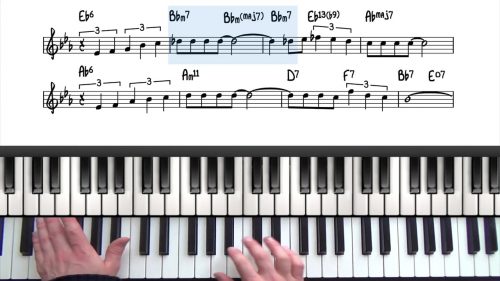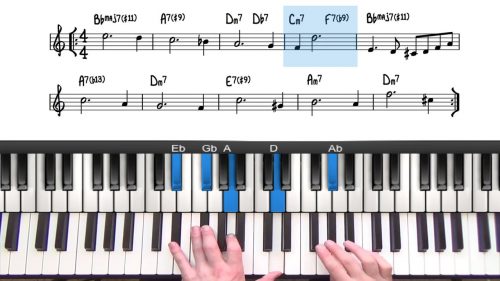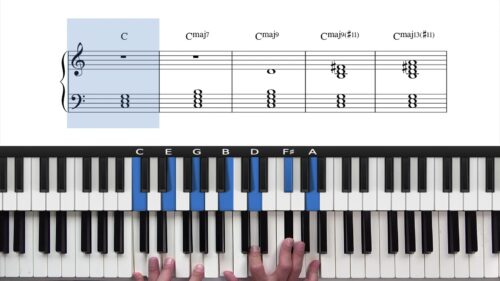9ths, 11ths, & 13th Practice Drills
In this lesson, we’re going to stack the chord tones sequentially in thirds, playing the 7th chord in our left hand, and the 9, #11, and 13 in our right hand.
Major 13th Chords – Stacked 3rds
Starting with C Major, let’s move around the circle of 5ths. A little trick here is that when voicing major 13th chords like this, your right hand is always playing a major triad off the 9th. Visualizing the chord in 2 parts will prepare you for the upcoming study of upper structure triads.
Let’s now work through the major 13th chords in all 12 keys.
Minor 13th Chords – Stacked 3rds
The second drill in this practice slot is the minor 13th chord.
If we remember that over the major 13th chord, our right hand always played a major triad off the 9th, well for minor 13th chords, the right hand always plays a minor triad off the 9th – so that’s a nice little trick for you to remember.
Dominant 13th Chords
The third and final drill in this practice slot is the extensions over dominant chords. An important point is that your dominant chord voicings will contain the #11 as opposed to the natural 11.
This is because dominant chords contain a natural 3rd, just like the major chord, and so if we play the natural 11, we get that dissonant half step interval.
So all we need to do is play our major 13 voicing, and then flatten the 7, and we then have C13#11 – again you can look at this as a major triad off the 9th.
The Upper & Lower Structure
Viewing the chord as a lower structure and an upper structure is the foundation for exploring upper structure harmony and we get all kinds of variations by manipulating our hands independently.
Just to quickly give you a taste of what’s to come. For dominant chords, we can alter the upper extensions to access different ‘colours’ and ‘textures’.
Lesson Downloads
-
Chord Extensions Practice Plan File Type: pdf
Practice Tips
There’s a few important points to remember for the upper extensions
-
The 13th is the highest extension, if we extend past the 13th, we get back to the root.
-
Remember that the 9 is the same note as the 2 (but an octave higher), the 11 is the same note as the 4(but an octave higher), and the 13 is the same note as the 6(but an octave higher).
- Remember that for Major and Dominant Chords, the 11 will typically be sharpened by a half step to the #11, this removes the dissonant half step interval between the major 3 and the natural 11.






this by far is one of my top fave lessons 😀 such a big relief (on my part haha) to finally understand how 9th, 11th and 13th chords are built .. Thanks very much for the wonderful lesson! Love it!
I think the one question I only have is – so if any major and dominant (13) chords are understood to have a #11th – why is it that when labelling LH chords on top of each bar on a score – for example C13 (#11) – that it still needs to be indicated that the 11th is a #? or is it the proper way to write 13th chords? 🙂 Thank you Hayden!
Brill lesson! Thanks.
Helpful. I’m still adjusting to seeing the keyboard numerically and not just as notes. Life long learning.